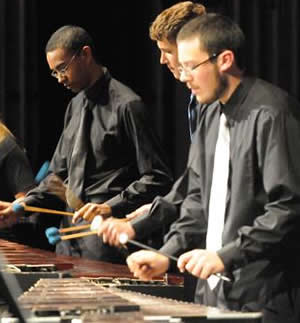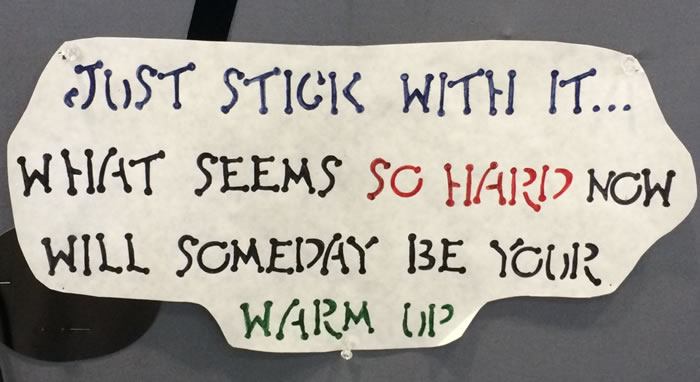Monday, March 30, 2015
IN THIS ISSUE:
Sight Reading 101 | Photos from the Classroom
 A week has passed since the big contest and George, a first-year band director in Podunk, Oklahoma still can’t get over the feelings of inadequacy. His band did well on the stage -- a first division -- but the "III" in sight-reading still pains him. He keeps re-living the study period, kicking himself for only getting through two pages of the score. If only he'd had enough time to mention the D.C. perhaps the band wouldn't have fallen apart. Of course, since the kids were not paying attention most of the time, since several of them had their phones out taking "selfies" during the study period, perhaps the problems go much deeper. Maybe he should have prepared better...
A week has passed since the big contest and George, a first-year band director in Podunk, Oklahoma still can’t get over the feelings of inadequacy. His band did well on the stage -- a first division -- but the "III" in sight-reading still pains him. He keeps re-living the study period, kicking himself for only getting through two pages of the score. If only he'd had enough time to mention the D.C. perhaps the band wouldn't have fallen apart. Of course, since the kids were not paying attention most of the time, since several of them had their phones out taking "selfies" during the study period, perhaps the problems go much deeper. Maybe he should have prepared better...
Sight-reading bands can be divided into three types;
1) bands that read confidently with good tone quality and pitch, making the music sound as if it had been rehearsed.
2) bands that are so apprehensive about the experience that they don’t support and "clam up" any time the music calls for smaller section playing. These bands are unable to create any musical expression, even though they may be technically and rhythmically proficient.
3) bands that obviously lack the fundamentals necessary to successfully play a piece of music at sight, or groups that lack the discipline to concentrate for 15 minutes.
Some key elements of a good sight-reading band
- Well-disciplined attitude and work ethic
- Brains and guts (I use this term over and over in our preparation)
- Fundamental training that includes characteristic tone, good intonation, key recognition, meter and rhythmic understanding, articulations, musical terms and dynamics
- Some artistic ability to understand phrasing, melody/accompaniment, balance and blend
- A director who displays confidence and musical knowledge and who is thoroughly acquainted with the contest rules and procedures
- Extensive preparation
- The importance of sight-reading is completely understood by students and director. If it’s important to you, it’s important to them. Conversely, if it’s an afterthought to you, it’s an afterthought to them.
There are many other factors, but these are of paramount importance.
Preparation is key. Here are some guidelines for practice.
- Start early. For my April State Contest, I began reading once a week in January. As the contest gets nearer, increase the frequency.
- Be VERY familiar with your state rules regarding sight reading. Communicate them with the students.
- Approach each practice session just like it’s the real thing. Read (or paraphrase) the instructions, time your session, do everything just like you would at contest.
- Choose one, possibly two methods you want to utilize. I judged a band once that tried to impress me by using every method known to man. They counted, clapped, sizzled, air-played, etc. The result was a convoluted prep period where nothing was done very well. Needless to say, I was not impressed.
- Be sure your students completely understand the procedures you will be using in the room. At the first practice session I pass out a sight-reading handout with the following guidelines:
- Enter the room quietly, orderly and professionally.
- The room will have to be set up. Be patient and quiet.
- Sight-reading music will be passed out by the room monitor. Make sure you have the correct part. If you don’t, raise your hand immediately.
- The monitor will read the directions. Be attentive.
- When time begins, take the first 30 seconds to study the part with your stand partner. Point to key changes, accidentals, time signatures, style and tempo changes, and any other potential problem areas.
- When the director begins to instruct, give him (or her) you full attention.
- During the study period you will be asked to do things such as "air-play", finger the notes and point at various things. PARTICIPATE.
- When time is called:
- Play our warm-up note (concert F)
- Perform the piece to the best of your ability (brains and guts!)
- When we are done, wait for instructions
- Leave the room the way you entered it -- quietly, orderly and professionally.
Other thoughts about practicing:
- Every sight-reading practice session should include a rating and feedback ("today you would have received a rating of ___. Here’s why...")
- If possible, have another director be your "judge" during practice. Let them give rating and feedback.
- Be diligent about the little things -- posture, every student doing the procedure the same way, EVERYONE participating, etc.
- There are many good sight-reading books available, in a variety of instructional levels. I use these books in the early stages, then graduate to "real" pieces.
- In Oklahoma and Texas, we use music published by RBC. Previous year's sight-reading music is available to purchase. Make a folder.
- Start easy to create confidence. With my 6A Wind Ensemble, we always started with a level 1. By the time contest rolled around we were reading level 6.
- Look at your calendar and plan every sight-reading day. Frequency should increase as contest gets closer. Plan the level for every session.
Tips for the actual sight-reading contest:
- Don't deviate from your procedure. Stick with the plan.
- Prepare in advance who will play solos if needed, and what cues should be covered.
- Don't misuse your time. I do a 30-second study period, then a few second of big-picture items, then we get right to the air play or counting. I judged a band once where the director talked for 3+ minutes before the students got to do anything. Don't talk too much.
- As you go through the score, make mental notes of places you need to hit a second time.
- Stress key, meter, road map (repeats, D.C. or D.S., etc)
- Look at the percussion parts. Don't ignore them.
- Talk in the same manner that your students are used to hearing. No panic in your voice. They have to be brave (guts) -- so do you.
- Be sure you ask the room monitor for a 1-minute warning.
- I don't allow questions except in an emergency. A good director will answer most questions about the music before they are asked.
- Be sure to mention musical issues. Talk phrasing and style, not just notes and rhythms.
- Use your set up. Don't seat a 30-piece band in a set up for a 70-piece band.
Sight-reading can be very intimidating, especially for young or inexperienced directors. Teaching sight-reading skills basically means teaching fundamentals of playing. You can't teach your students to be great sight-readers in "ten easy lessons" or by skipping around haphazardly from topic to topic. You need to present materials in sequential order. As your band gets more proficient at sight-reading, don't be surprised if you see the positive effects carry over to your concert performance. Good luck.
Finally, avoid these actual quotes blurted out during the pressure of the moment:
- Adagio -- "walking tempo"
- Soli -- "more than one solo played at the same time by a different instrument"
- Maestoso -- "march tempo"
- Leggiero -- "played in a lazy manner"
- Tam-tam -- "that is a misprint. It means play it on the tom-tom."
- p-f -- "it means that every other measure is played soft, then loud"
- Rubato -- "a variation of vibrato. Just play it straight for now."
- Allegro -- "fast as all get out"
- Allegro ma non troppo -- "play fast, but with no definite beat"
- D.C. -- "that means do commence"
 |
Charlie Bartrug Charles Bartrug recently retired after 33 years as a public school band director. The last thirteen years were spent as High School Band Director and Coordinator of Instrumental Music in Yukon, OK. Before coming to Yukon, Mr. Bartrug was band director at Midwest City HS, Guthrie High School, Owasso Junior High, and Collinsville Junior High. Bands under Charlie's direction have earned twenty one O.S.S.A.A. Sweepstakes Awards and three Double Sweepstakes Awards. The Guthrie High School Concert Band performed as an honor group for the OMEA Convention in 1999, and the Yukon High School Wind Ensemble performed in 2014. Mr. Bartrug is a recent inductee into the Oklahoma Bandmaster's Hall of Fame. He earned National Board Certification in 2004, was the 2005 Oklahoma Bandmasters Association Band Director of the Year, the 2005 Yukon High School Teacher of the Year, and a 2009 OMEA Exemplary Teacher. Charlie served as the Oklahoma Music Educator's Association Band Vice-President, and has presented clinics at the OMEA and OBA Conventions. He was twice named the A.S.B.D.A. Stanbury Award winner for outstanding young band director at the State and Region level, and was twice named Guthrie High School Teacher of the Year. Two highlights of Charlie's career have been teaching band alongside his wife Nancy for 26 years and seeing his 18-year old son Josh develop into a great young man and an outstanding musician. |
We are going to start a new part of the Quick Note called "Pictures from the Classroom". As our road reps see things that they think are particularly awesome, they will snap a photo and we will include it in the Quick Note. Here is a picture of a poster hanging in the Washington, MO band room. We loved it!

